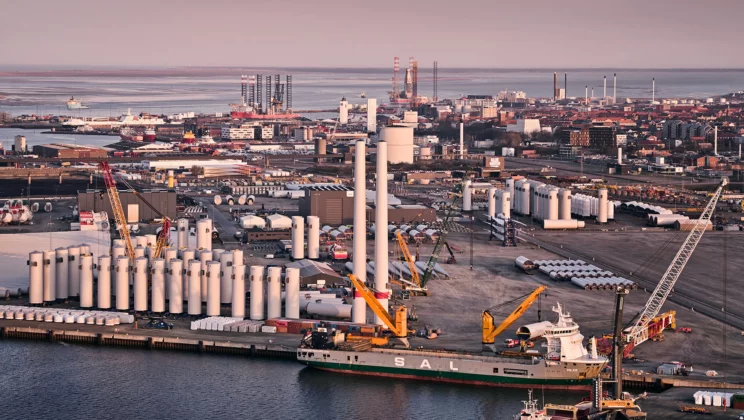Port Esbjerg gets digital twin
Port Esbjerg has joined forces with global consultancy firm Moffatt & Nichol to develop a ‘digital twin’ of the port in order to increase the efficiency of offshore wind shipping services by simulating future projects and optimising infrastructure accordingly.
“Port Esbjerg and the entire value chain at Esbjerg has extensive experience in supporting offshore wind projects, but we have to be able to simulate the future if we are to plan optimally now, so we are looking forward to working with Moffatt & Nichol,” explains Port Esbjerg CEO Dennis Jul Pedersen.
Moffatt & Nichol is a global infrastructure advisory firm. In addition to its headquarters in southern California, the company has 40 offices in Europe and North and South America. The company specialises in port planning, development and design, and has been involved in some of the largest projects in the world in recent years. The company has been responsible engineer at the four largest US shipping ports, Connecticut, New Jersey, New York and Virginia.
The offshore wind market is expected to grow considerably, and that implies a responsibility for those ports that service and support the industry. Rising demand for offshore wind and the increasing scale of components is placing demands on port infrastructure. Ports must therefore plan and be proactive if they are to create the flexibility these projects require. With a ‘digital twin’, Port Esbjerg can prepare for the future.

Port Esbjerg welcomes the collaboration with the global consulting company Moffatt & Nichol.
SAL and Port Esbjerg develop innovative Ro-Ro concept
Scandinavian Auto Logistics and the Port of Esbjerg are working together to develop a new Ro-Ro terminal concept. Named ‘Flexible Multi-Terminal’ by the partners, it will be capable of handling cars, trailers, containers and heavy cargoes.
Scandinavian Auto Logistics is majority-owned by the Grimaldi Group, a multinational logistics company that commands one of the world’s largest fleets of Ro-Ro, multifunction, car and truck freighters as well as Ro-Ro passenger ships, cruise ships and ferries.
Managing Director of Scandinavian Auto Logistics, Henrik Otto Jensen, explains that: “The opportunity to handle all types of Ro-Ro freight with one of the largest fleets in the world provides the flexibility to benefit from the large network at Grimaldi Lines.”
And indeed, the new terminal concept can handle many different types of ship, thus ensuring the greatest possible flexibility in planning. Moreover, loads can be prepared for shipping right at the ships’ ramps, while storage areas are less than 100 metres from the dockside.
Investing in the new Flexible Multi-Terminal concept improves port capacity and gives access to Grimaldi Lines’ large route network. This allows for transporting various types of goods from the hinterland to three continents that represent some of the fastest growing markets in the world.
Grimaldi Group runs eight shipping companies that connect Northern Europe, the Mediterranean, West Africa and North, East and South America as well as having a presence in auto logistics through Scandinavian Auto Logistics, whose Managing Director, Henrik Otto Jensen, says: “We believe flexibility and efficiency should be combined when you ship complex goods around the world – and that starts as soon as we receive the goods at the port of Esbjerg.”

The new concept ‘Flexible Multi-Terminal’ allows you to handle cars, trailers, containers and heavy loads.
Maersk Drilling connects to shore-to-ship power at Esbjerg
In future, Maersk Drilling’s large rigs can cut their engines when docked at Esbjerg. Port Esbjerg and Maersk have partnered up to invest in a shore-to-ship power plant that can provide green power for up to three drilling rigs at once.
The shore-to-ship power plant will not only mean marked reductions in CO2 emissions, it will also noticeably improve the local environment for ship and port workers.
“We’re delighted to have the opportunity to use green shore-to-ship power while our rigs are docked at Esbjerg to be readied for new assignments. Maersk Drilling is a first mover in the industry with the ambition to halve its carbon emissions intensity by 2030, and the use of shore-to-ship power contributes to this objective,” says Claus Bachmann, Head of North Sea Division at Maersk Drilling.
The shore-to-ship power plant has a capacity of 1,300 Amp/1.5 MW and can supply green power to up to three drilling rigs, which requires up to 10,000 kWh every 24 hours. The potential reduction in carbon emissions is substantial but the actual figures will naturally depend on how long the rigs are docked. Emissions of SOx and NOx will also be reduced, as will the level of noise pollution.
Many of the other ships at the port have had the option to connect to shore-to-ship power for several years; the news is that the port of Esbjerg now has the capacity to supply shore-to-ship power to drilling rigs, which require huge quantities of power.
“More and more customers ask for shore-to-ship power, so for us, it’s not just a matter of participating actively in the green transition, on which we’re already heavily focused. It’s also a commercial necessity, which is why we’re in the process of installing more shore-to-ship power plants at the port, so even more of our customers have the opportunity to use green power,” explains Port Esbjerg CEO Dennis Jul Pedersen.

New shore power system makes it possible for Maersk Drilling's large drilling rigs to switch off the engine when they are at Port Esbjerg.
Go to overview

